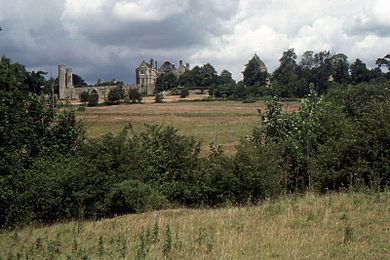Senlac Hill facts for kids
Senlac Hill (also called Senlac Ridge) is believed to be the place where King Harold Godwinson set up his army. This happened during the famous Battle of Hastings on October 14, 1066. The hill is close to the modern town of Battle, East Sussex, in England.
The name Senlac became well-known thanks to a historian named E.A. Freeman. He lived in the Victorian era. Freeman got the name from an old writer called Orderic Vitalis, who wrote about the battle. Freeman thought the Normans might have called the area "Blood lake" as a play on words, because the English name might have sounded like "Sand lake."
Orderic Vitalis probably knew the English name for "Senlac." He grew up in England and had an English mother. He was also taught by an English monk. However, some historians don't agree with Freeman's idea. They point out that Orderic was born nine years after the battle. Also, earlier writers didn't use the name Senlac.
Contents
Where the Name "Senlac" Came From
The name Senlac was first brought into English history by the Victorian historian E.A. Freeman. His only source for this name was the Anglo-Norman writer Orderic Vitalis. Freeman believed that Senlac was the correct name for the Battle of Hastings site. He thought the hill itself was called Senlac, and it was near a stream named Santlache.
Orderic wrote that Harold's army gathered for the battle "at the place which was anciently called Senlac." He also said the battle itself was fought "in the field of Senlac."
The Idea of "Blood Lake"
Orderic Vitalis was born in Atcham, Shropshire, England. His father was a French priest, and his mother was English. When Orderic was five, his parents sent him to study with an English monk named Siward. Siward ran a school at the Abbey of SS Peter and Paul in Shrewsbury.
Even though Orderic moved to a monastery in Normandy when he was ten, he stayed connected to England. Freeman thought it was very possible that Orderic knew the English name for the ridge.
A book called The Chronicle of Battle Abbey describes a large ditch. It was called Malfosse. This ditch opened up during or after the battle. Many soldiers from both sides fell into it and were crushed. The book says that "streams of blood" flowed as far as one could see. For centuries after the battle, there was a local story. People said the soil in the area would turn red after heavy rain.
The poet Michael Drayton wrote about this in 1612:
..."Asten once distained with native English blood;
Whose soil, when yet but wet with any little rain,
Doth blush, as put in mind of those there sadly slain,
When Hastings' harbour gave unto the Norman powers.
Whose name and honours now are denizened for ours.
That boding, ominous brook !"
From Michael Drayton's Poly-Olbion 1612
Freeman thought that Senlac meant "Sand Lake" in Old English. He suggested that the Norman conquerors then called it Sanguelac in French. Freeman saw this as a pun, because "Sanguelac" translates to "Blood Lake" in English.
Is the Name "Senlac" Correct?
Not all historians agreed with Freeman's ideas. John Horace Round wrote a book in 1895 called "Feudal England." In it, he strongly disagreed with Freeman. He argued that Senlac was not an English word. He thought it was just a made-up word, or a "fad," by Orderic Vitalis.
Two Norman writers, William of Jumièges and William of Poitiers, lived at the time of the battle. They did not record the battle site as Senlac. The Chronicle of Battle Abbey simply called the location Bellum (which means "Battle" in Latin). This is where the town of Battle gets its name.
However, later documents show that the abbey did own a piece of land called Santlache (Sandlake). The name Sandlake continued to be used for several centuries for a small area in Battle.
What "Senlac" Might Mean
The name Hastings likely came from the Anglo-Saxon words Hæsta-inga. This meant "clearing of Hæsta's people." Another idea, also from Anglo-Saxon, is Asten-enge. This means "meadow of the Asten," which is the stream that flows through the battlefield.
Freeman thought that what Orderic Vitalis called the battlefield, Senlac, might have been a changed version of the original Anglo-Saxon name. Other experts have suggested that the Anglo-Saxon form could have been scen-leag. This would mean "beautiful meadow."
Another idea for the name Senlac comes from the local area. There are many iron-rich sandstone deposits there. The local Wealden iron industry was active even before the Romans arrived and continued until the late 1700s. The Saxon term Isen-Lacu, meaning "iron pond," is a possible origin. If this term was changed into Latin, it might have become "Senlac." So, Senlac Hill could mean the hill next to the "Iron Pond." This might mean the actual location of Senlac Hill is different from what we think.



